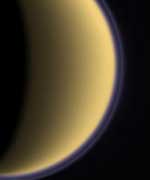As scientists begin to unpack more than 3,000 containers of samples of the sun brought to Earth by NASA’s Genesis mission, the Mishap Investigation Board (MIB) has identified a likely direct cause of the failure of Genesis’ parachute system to open.
The parachute system failed to deploy when Genesis returned to Earth September 8, 2004. The MIB, analyzing the Genesis capsule at a facility near Denver, said the likely cause was a design error that involves the orientation of gravity-switch devices. The switches sense the braking caused by the high-speed entry into the atmosphere, and then initiate the timing sequence leading to deployment of the craft’s drogue parachute and parafoil.
“This single cause has not yet been fully confirmed, nor has it been determined whether it is the only problem within the Genesis system,” said Dr. Michael G. Ryschkewitsch, the MIB chair. “The Board is working to confirm this proximate cause, to determine why this error happened, why it was not caught by the test program and an extensive set of in-process and after-the-fact reviews of the Genesis system.”
Meanwhile, scientists unpacking samples at NASA’s Johnson Space Center (JSC), Houston, curation facility remain upbeat in their assessment of the prospects for obtaining useful science from the recovered samples.
The facility counted more than 3,000 tracking numbers for the containers that hold pieces of wafers from the five collector panels. The panels secured samples of atoms and ions from the solar wind that were collected during Genesis’ nearly three-year mission in deep space. Some of the containers hold as many as 96 pieces of the wafers. The team has been preparing the samples for study since the science payload and recovered samples arrived at JSC October 4.
Planning is under way for preliminary examination of the samples to prepare for allocation to the science community. The samples eventually will be moved to the JSC Genesis clean room where they will be cleaned, examined and then distributed to scientists, promising researchers years of study into the origins and evolution of the solar system.
“We cheered the news from the science team about the recovery of a significant amount of the precious samples of the sun,” said Dr. Ghassem Asrar, deputy associate administrator for the Science Mission Directorate at NASA Headquarters, Washington. “Despite the hard landing, Genesis was able to deliver. However, we await the final report of the Mishap Board to understand what caused the malfunction, and to hear the Board’s recommendations for how we can avoid such a problem in the future,” he added.
The recovered remains of the Sample Return Capsule (SRC) are undergoing engineering inspections and tests at the Waterton, Colo., facility of Lockheed Martin Astronautics (LMA). The Genesis spacecraft and SRC were built at Waterton. Lockheed Martin is supporting the MIB both to examine the recovered hardware and in assembling documentation relevant to the development of the space system.
“Both Lockheed Martin and JPL have been providing every possible support to our investigation. All of the people from both organizations who were involved in the Genesis project have been extremely professional and cooperative in helping the Board do its work,” said Dr. Ryschkewitsch.
The safety critical pyrotechnic devices and the damaged lithium sulfur dioxide battery have been secured to allow safe operations. The battery has been transported to the Jet Propulsion Laboratory in Pasadena (JPL), Calif., to begin detailed evaluation.
The MIB is evaluating the recovered hardware, pertinent documentation, impact site recovery activities and interviewing people from development teams. The MIB is using a fault tree as its guide. A fault tree is a formal method for determining, organizing and evaluating possible direct causes for a mishap and to trace them to root causes.
The Board’s charter is to examine every possible cause and to determine whether it was related to the mishap. The Board expects to complete its work by late November.
For information about NASA and agency programs on the Web, visit:
Original Source: NASA News Release



